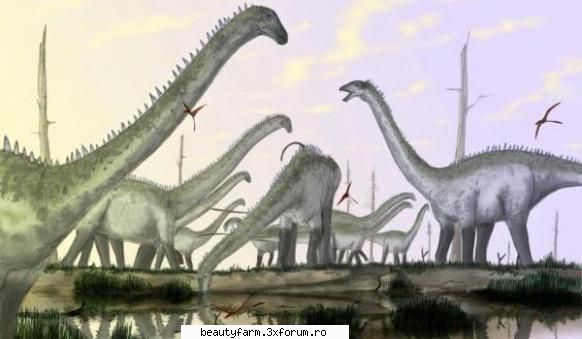ADMIN-ELECTRIK_CAT
Administrator
 Din: CAT LAND
Inregistrat: acum 19 ani
Postari: 8870
|
|
Sauropodele - imposibilii dinozauri
Faimoasele reprezentari grafice ale unora dintre cei mai cunoscuti dinozauri sunt total gresite, daca nu chiar imposibile, anunta cercetatorii din cadrul universitatilor din Portsmouth si California. In aceasta situatie, o intreaga galerie de imagini ar trebui retrasa de pe piata si refacuta, sustin aceiasi experti.
Cel mai evident caz este cel al sauropodelor, animale emblematice pentru disparuta lume a dinozaurlor. Reprezentantii acestei familii ajungeau frecvent la lungimi de 30 de metri, un singur exemplar cantarind cam cat 10 elefanti la un loc. Ei sunt usor de recunoscut din reprezentarile grafice datorita gatului foarte lung si a capetelor extrem de mici in comparatie cu restul corpului.
Dr. Mike Taylor si Darren Naish de la Universitatea din Portsmouth, alaturi de Matt Wedel de la Universitatea din California, afirma la unison ca modul in care acestia au fost reprezentati pana in prezent este unul total eronat. Sauropodele sunt infatisate in pozitii imposibil de atins in viata reala, asa cum ar fi pozitia gatul care este aproape paralela cu solul. Studii recente arata ca, de fapt, sauropodele isi tineau gatul in pozitia verticala, asemenea girafelor din ziua de azi, ceea ce le permitea sa atinga lejer o inaltime de 15 metri.
„Doar daca sauropodele si-ar fi tinut gatul altfel decat orice alt animal vertebrat, putem afirma ca reprezentarile acestor animale sunt corecte. In realitate, gatul acestora era orientat un sus, eventual cu o usoara curbura in forma literei S. Putem vedea acest lucru cel mai bine in cazul pasarilor mari de azi, animalele care pastreaza cel mai bine trasaturile dinozauriene. In caz contrar, presiunea exercitata asupra vertebrelor ar fi dus la fracturarea gatului datorita greutatii enorme a acestuia”, concluzioneaza Matt Wedel.
ScienceDaily (May 27, 2009) — Famous depictions of the largest of all known dinosaurs, from film and television to museum skeletons, have almost certainly got it wrong, according to new research.
Sauropods are the most iconic of prehistoric creatures. They were up to 30 metres long, weighed as much as 10 elephants, and are instantly recognisable by their very long necks and small heads. They are the centrepieces in most natural history museums worldwide.
Recent depictions such as the BBC's Walking With Dinosaurs show them with their long necks held horizontal and their heads near the ground. But now scientists are saying the low-necked sauropod pose is a mistake: new evidence indicates that they held their necks aloft like giraffes and all other living land vertebrates, making them up to 15 metres tall.
Dr Mike Taylor and Dr Darren Naish, of the University of Portsmouth, and Dr Matt Wedel, of Western University of Health Sciences in California, argue that while sauropods could hold their necks low, it was not their habitual posture.
They studied X-rays of members of 10 different vertebrate groups and found that while the neck is only gently inclined in salamanders, turtles, lizards and crocodilians, it is vertical in mammals and birds – the only modern groups that share the upright leg posture of dinosaurs.
Dr Taylor said: “Like the animals we have with us today, they would have spent most of their time with their necks elevated, except when drinking or browsing at low levels.”
Modern vertebrates, from cats and humans to sauropods’ closest living relatives, the birds, hold their necks aloft in a vertical or near-vertical position.
Dr Wedel said: “We can’t just study fossil bones by themselves. Dinosaurs were living animals and to understand how they lived, we need to look at animals that are alive today. In this case, our evidence shows the present is the key to the past.”
The neck vertebrae of sauropods fit together mainly by way of ball and socket joints. In addition, the top part of each vertebra has a pair of facets, two at the front and two at the back, which glide past each other when the neck bends.
Dr Taylor said: “Scientists have assumed that each pair of facets must maintain at least a 50 percent overlap at all times; but looking at what ostriches and giraffes do, we see that their facets can slide much further, until they hardly overlap at all. This means that sauropods would have had a far greater range of neck movement than has been thought in recent times.
“Unless sauropods carried their heads and necks differently from every living vertebrate, we have to assume that the base of their neck was curved strongly upwards. In some sauropods this would have meant a graceful swan-like S-curve to the neck, and a look quite different from the recreations we are used to seeing today.”
Low necked poses for sauropods have been used for countless plastic toys and have become part of mainstream culture, thanks in part to the BBC’s Walking with Dinosaurs, and to new museum exhibits such as one at the American Museum of Natural History in New York.
Professor Mike Benton at Bristol University’s Department of Earth Sciences, said: “It's hugely important to understand how sauropod dinosaurs functioned. They were so huge – ten times the size of an elephant – and yet they were successful animals. This new work provides plausible evidence that sauropods held their necks elevated, rather than horizontally, as had been assumed.
“The new work is based on studies of living animals, but the next step will be to carry out engineering studies to see whether the new or old neck positions are energetically more efficient. If you have a long neck that weighs a tonne or more you must hold it in a neutral position where stresses and strains are minimised.”
30.5KB
_______________________________________
 PM-URI PM-URI  №1 №1
  TUTORIAL 3XFORUM TUTORIAL 3XFORUM
 | REPORT BROKEN LINKS | | REPORT BROKEN LINKS | 
|
|



 №1
№1



